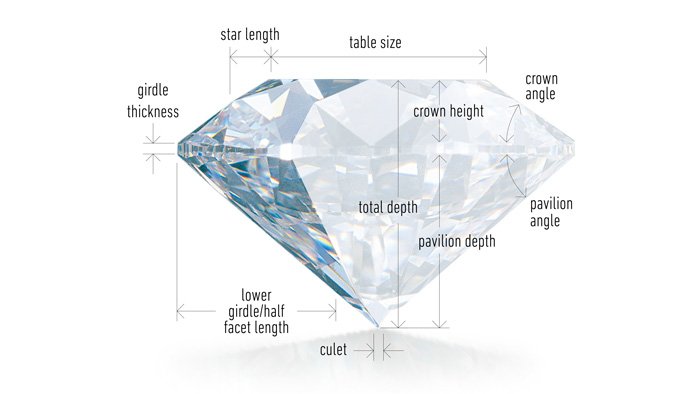Conflict Free Natural Diamonds
WHAT IS DIAMOND CLARITY?
Diamond Clarity Refers to the Absence of Inclusions and Blemishes
To understand diamond clarity, we must first understand how diamonds are created. Natural diamonds are the result of carbon exposed to tremendous heat and pressure deep in the earth. This process can result in a variety of internal characteristics called ‘inclusions’ and external characteristics called ‘blemishes.’ Evaluating diamond clarity involves determining the number, size, relief, nature, and position of these characteristics, as well as how these affect the overall appearance of the stone. If you are trying to determine what is the best clarity for a diamond, remember that no diamond is perfectly pure. But the closer it comes to purity, the better its clarity.

4Cs
Diamond Color
Diamond Color Actually Means Lack of Color
Understanding what diamond color means helps in choosing the right diamond. Interestingly, the diamond color evaluation of most gem-quality diamonds is based on the absence of color. A chemically pure and structurally perfect diamond has no hue, like a drop of pure water, and consequently, a higher value. GIA’s D-to-Z diamond color-grading system measures the degree of colorlessness by comparing a stone under controlled lighting and precise viewing conditions to masterstones of established color value. Many of these diamond color distinctions are so subtle that they are invisible to the untrained eye; however, these distinctions make a very big difference in diamond quality and price. Hence, it is important to get a GIA expert’s opinion in evaluating the best color for your diamond.

DIAMOND CLARITY
Diamond Clarity Refers to the Absence of Inclusions and Blemishes
Understanding what diamond color means helps in choosing the right diamond. Interestingly, the diamond color evaluation of most gem-quality diamonds is based on the absence of color. A chemically pure and structurally perfect diamond has no hue, like a drop of pure water, and consequently, a higher value. GIA’s D-to-Z diamond color-grading system measures the degree of colorlessness by comparing a stone under controlled lighting and precise viewing conditions to masterstones of established color value. Many of these diamond color distinctions are so subtle that they are invisible to the untrained eye; however, these distinctions make a very big difference in diamond quality and price. Hence, it is important to get a GIA expert’s opinion in evaluating the best color for your diamond.

DIAMOND CUT
Understanding Diamond Cut
Diamonds are renowned for their ability to transmit light and sparkle so intensely. We often think of a diamond’s cut as shape (round, heart, oval, marquise, pear), but what diamond cut actually does mean how well a diamond’s facets interact with light. Precise artistry and workmanship are required to fashion a stone so its proportions, symmetry and polish deliver the magnificent return of light only possible in a diamond. Achieving the best cut for a diamond reflects in the stone’s final beauty and value. And of all the diamond 4Cs, it is the most complex and technically difficult to analyze. To determine the cut grade of the standard round brilliant diamond – the shape that dominates the majority of diamond jewelry – GIA calculates the proportions of those facets that influence the diamond’s face-up appearance. These proportions allow GIA to evaluate what the best cut for a diamond is, by studying how successfully a diamond interacts with light to create desirable visual effects, such as: Brightness: Internal and external white light reflected from a diamond Fire: The scattering of white light into all the colors of the rainbow Scintillation: The amount of sparkle a diamond produces, and the pattern of light and dark areas caused by reflections within the diamond

DIAMOND CARAT WEIGHT
Diamond Carat Weight Measures a Diamond’s Apparent Size
To put it simply, diamond carat weight measures how much a diamond weighs. A metric “carat” is defined as 200 milligrams. Each carat is subdivided into 100 ‘points.’ This allows very precise measurements to the hundredth decimal place. A jeweler may describe the weight of a diamond below one carat by its ‘points’ alone. For instance, the jeweler may refer to a diamond that weighs 0.25 carats as a ‘twenty-five pointer.’ Diamond weights greater than one carat are expressed in carats and decimals. A 1.08 carat stone would be described as ‘one point oh eight carats.’ All else being equal, diamond price increases with diamond carat weight because larger diamonds are rarer and more desirable. However, two diamonds of equal carat weight can have very different values (and prices) depending on three other factors of the diamond 4Cs: Color, Clarity, and Cut. While now you know what carat means, it’s also important to remember that a diamond’s value is determined using all of the 4Cs, and not just carat weight













